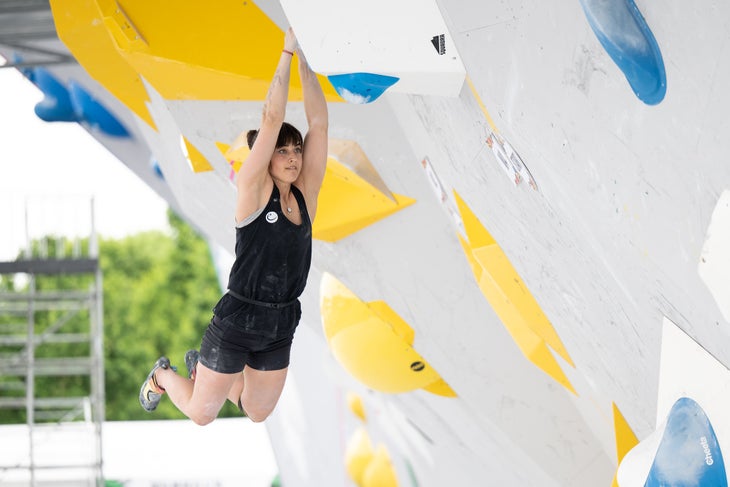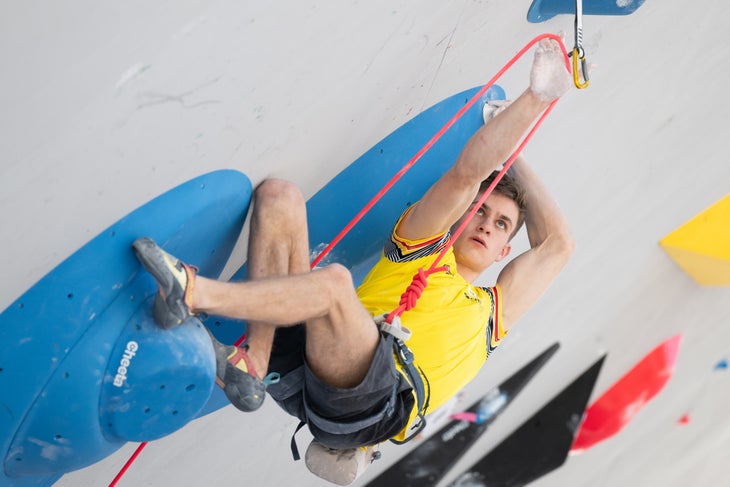Heading out the door? Read this article on the new Outside+ app available now on iOS devices for members! Download the app.
The Paris 2024 Olympic Games are on the horizon, with the two Sport Climbing events—Bouldering & Lead Combined and Speed—running August 5 through 10 at the climbing venue in Le Bourget, in the Parisian suburbs. If you’re already a climber, then you’ll be fluent with our sport’s technical lingo and should be able to follow the commentary with ease. However, if you’re new either to climbing (the sport) or Sport Climbing (the Olympic event), you may be baffled by all the jargon. The comp climbing terms in this article will make it simple to follow the commentary and easier to understand what’s happening on the wall.
Sport Climbing Terms
beta: A specific sequence of hand and foot movements; different climbers, because of their unique strengths, height, or limb length, may use different beta to negotiate the same set of holds.
bicycle: An oppositional footwork technique in which one foot pushes against the top of a hold while the other foot pulls against it, typically in a toe hook. The term also describes situations in which the same push-pull technique is used on adjacent footholds.
bouldering: Ropeless, gymnastic climbing focused on pure difficulty. In Paris, bouldering will take place on a 15-foot-tall wall and be part of a combined event with lead climbing. Competitors will be given five minutes to complete each of four boulder problems in the semifinals and four minutes in the finals.
boulder problem: A bouldering route. Also sometimes shortened to problem.
chalk: Magnesium carbonate used to dry sweaty hands, a practice imported from gymnastics. To “chalk up” is to apply chalk from a chalk bag worn around the waist while lead climbing or from a chalk pot on the ground used in bouldering.
coordination move: A complex dynamic move that involves simultaneously executing multiple techniques—e.g., a dyno paired with a toe hook.
clip: To secure the rope in the bottom carabiner on a quickdraw; in lead climbing, competitors are automatically disqualified if they bypass a clip.
close-handed: A strenuous grip position in which the climber’s fingers are bent over, as with a crimp.
crimp: A closed-handed technique used on small edges, in which the fingers compress onto the hold and the thumb folds over the index finger.
deadpoint: To launch for a hold dynamically, keeping your feet on the wall when contacting the target grip; the name refers to the momentary “dead point” of weightlessness atop the lunge.
drop knee: A footwork technique used on overhanging (>90°) terrain; one foot is placed high and to the side, and then the climber rotates over that big toe until their kneecap points toward the ground, sucking their hip in toward the wall to extend their reach.
dyno/dynamic: In a dyno, you sag down, coil, and then leap for a hold, going airborne as if making a slam dunk. Moving dynamically means that you more often dyno or deadpoint than move statically between holds.
View this post on Instagram
edging: A footwork technique in which the big toe is placed laterally on a horizontal hold, with the climber’s hip turned into the wall (“frogged in”).
gaston: A handhold, taken vertically, that’s an “opposite sidepull”—the climber’s fingers on their palm side face away from the body, and the pull direction is outward. (Picture prying open an elevator door.)
heel hook: A footwork technique in which the heel is placed on a hold and the hamstring activated, to pull the heel in toward the body.
heel-toe cam: A footwork technique in which the heel is cammed against one hold and the toe against another, in opposition.
jib: A tiny handhold or foothold screwed onto a volume.
jug: A handhold that is big, incut, and easy to hold onto—named for its similarity to a water-jug handle; climbers often pause on these holds to shake out.
kneebar/kneescum: A way of partially unweighting your hands to either rest or execute a sequence by driving your upper knee/lower thigh against the underside of a hold while pushing into a foothold with your big toe to create opposition; a kneescum is a technical, insecure kneebar against a subtle feature.
lache: A bouldering move, imported from parkour, in which you hang from your arms, feet in the air, and use your feet and legs to initiate a swinging jump/dyno to a target hold or holds.

layback/lieback: Leaning sideways while holding the vertical edge of a hold or feature and walking the feet high in opposition.
lead climbing: Climbing on a rope, clipping into protection points as you go to secure a potential fall. In Paris, the overhanging lead wall is 45 feet high. Points are assigned based on how high each competitor climbs within their allotted 6 minutes. Completing the route without falling gets you the maximum 100 points.
match: To pair either both feet or both hands on the same hold, often shuffling the original foot or hand off to make room for the new extremity.
open-handed: A grip position in which the climber’s fingers are barely bent. The opposite of close-handed or crimp grips.
opposition: Tension created between holds using opposing forces, such as pulling on two sidepulls as if lifting a small refrigerator.
paddle dyno: A multi-part dyno in which you generate or redirect momentum toward your target hold by moving dynamically to and then off intermediate holds en route. It’s considered a type of coordination move.
pinch: An open-handed grip in which the fingers close around one part of the hold while the thumb presses into another part of it—like squeezing a brick.
pump/pumped/pumpy: The cumulative buildup of trapped blood and lactic acid in the forearms, which leads to hand and finger fatigue. “Pumpy” climbing is sustained in nature, without good rests. You know that feeling of lactic acid in your quads when you run up a hill? It’s like that but in your forearms—and worse.
quickdraw: Two carabiners linked by a d nylon connector and used to anchor the climber’s rope into the protection system (steel bolts + hangers). In lead climbing, competitors are not allowed to skip quickdraws or stand on the quickdraw or bolt hanger.
rose move: A cross-body reach in which you reach under (through) your opposite arm, sometimes turning the torso away from the rock wall. It can also be used as a verb: to rose or rose through.

shake/shake out: To recover from the pump by flicking the hand, wrist, and forearm to clear lactic acid.
sidepull: A hold taken vertically, with the palm side of the fingers facing toward the climber’s body and thumb facing away; the pull direction is medial.
sloper: A downsloping handhold or foothold that cannot be grabbed in a close-handed position and instead forces climbers to rely on friction and contact strength (their ability to exert downward pressure on the hold).
smear: A footwork technique in which climbers place the full forefoot of their shoe on a sloping hold and then articulate their ankle to increase friction between the shoe’s sticky rubber and the wall. (Imagine walking up a very steep slope in your running shoes: the heel-lifting posture of your foot is smearing.)
speed: At the speed event in Paris, climbers will sprint in various heats up a 45-foot, 5-degree-overhanging wall, climbing side-by-side on a standardized climb with specialized holds and slapping a finishing buzzer. Compared to the Lead and Bouldering routes, the speed route is very easy. But they move much more quickly. The men’s current world record is 4.79 seconds; the women’s is 6.24 seconds.
static: To reach a handhold slowly and in control, using muscular power to lock off and reach. To move statically is the opposite of moving dynamically.
toe hook/toe scum: A footwork technique that uses the top of the forefoot, levered or dragged against the down-facing side of a hold to create opposition.
undercling: A handhold that faces downward. Climbers grab them with their palm facing upward, like a waiter carrying a tray, and the pull direction is upwards or outwards, toward the body.
volume: A large, extruded, three-dimensional feature on the climbing wall, onto which smaller handholds and footholds might be bolted.
zone hold: In the bouldering event, zone holds are target holds partway up each boulder problem that must be held and controlled to earn points. The first zone hold is worth 5 points and the second 10 points. The finishing hold is worth the full 25 points, marking completion of the problem, even if you were to somehow skip (refuse to grab) the zone holds.
Matt Samet is a freelance writer and editor based in Boulder, Colorado. He is the author of the Climbing Dictionary and the memoir Death Grip.
